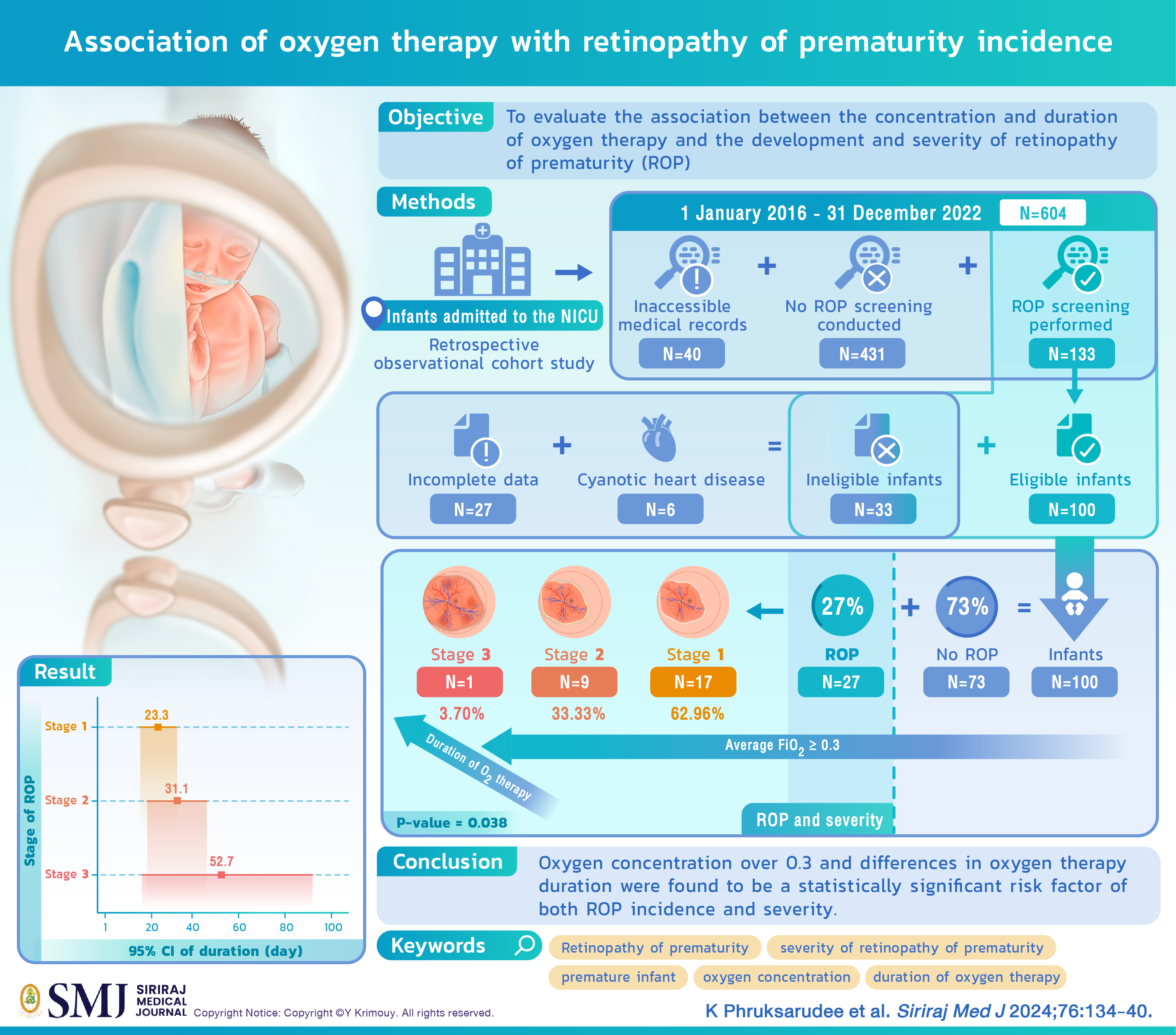Association of Oxygen Therapy Concentration and Duration with Retinopathy of Prematurity Incidence at Naresuan University Hospital
DOI:
https://doi.org/10.33192/smj.v76i3.267066Keywords:
retinopathy of prematurity, severity of retinopathy of prematurity, premature infant, oxygen concentration, duration of oxygen therapyAbstract
Objective: This study aimed to evaluate the association between the concentration and duration of oxygen therapy and the development and severity of retinopathy of prematurity (ROP). Additionally, it sought to examine the incidence of ROP at Naresuan University Hospital.
Materials and Methods: A retrospective observational cohort study was conducted, utilizing data from the medical records of infants admitted to the Neonatal Intensive Care Unit at Naresuan University Hospital, Phitsanulok, Thailand, from January 1, 2016, to December 31, 2022. The duration of various oxygen therapies was recorded in hours, and the concentration of oxygen administered per hour was calculated as the average fraction of inspired oxygen for each infant. These data were subsequently analyzed using STATA version 11.0.
Results: Out of 100 eligible infants, 27 (27%) were diagnosed with ROP at different severity levels: 17 infants (62.96%) with ROP stage 1, 9 infants (33.33%) with stage 2, and 1 infant (3.70%) with stage 3. There were no cases of Stage 4 or 5 ROP. The adjusted risk ratio revealed that infants receiving an average FiO2 of 0.3 or higher had a 1.64 times greater risk of developing ROP [95%CI 1.03-2.62], (P-value=0.038). Further analysis using mean difference regression showed a significant correlation between the duration of oxygen therapy and the severity of ROP.
Conclusion: This study suggests that regulating oxygen therapy to not exceed an FiO2 of 0.3 and administering it strictly as needed may mitigate the risk of developing ROP and its severe manifestations.
References
Woods J, Biswas S. Retinopathy of prematurity: from oxygen management to molecular manipulation. Mol Cell Pediatr. 2023;10:12.
Sun Y, Hellström A, Smith LE. Retinopathy of Prematurity. In: Martin RJ, Fanaroff AA, Walsh MC, editors. Fanaroff and Martin’s Neonatal-Perinatal Medicine. Philadelphia: Elsevier; 2020.p.1970-78.
Olevson C, Tufty G. Review of Retinopathy of Prematurity. S D Med. 2023;76:372-5.
Das PK, Hossain MM, Shirin M, Halim SP, Paul SP, Hossain AE. Effect of supplemental oxygen on development of retinopathy of prematurity. MedPulse International Journal of Pediatrics. 2020;15:11-6.
Teoh SL, Boo NY, Ong LC. Nyein MK, Lye MS, Au MK. Duration of oxygen therapy and exchange transfusion as risk factors associated with retinopathy of prematurity in very low birthweight infants. Eye (Lond). 1995;9:733-37.
Chutasmit K, Wongsiridej P, Sommai K, Siriwaeo S, Insawang P, Kitsommart R. Incidence and Risk Factors of Retinopathy of Prematurity, a 10-year Experience of a Single-center, Referral, Hospital. Siriraj Med J. 2021;73(12):777–85.
Chiang MF, Quinn GE, Fielder AR, Ostmo SR, Paul Chan RV, Berrocal A, et al. International classification of retinopathy of prematurity, third edition. Ophthalmology. 2021;128:e51-68.
Poovichayasumlit C. Retinopathy of prematurity at Thammasat University Hospital. Thammasat Medical Journal. 2020;20:297-306.
Tangadulrat C. Risk factor of retinopathy in Buriram Hospital. Medical Journal of Srisaket Surin Buriram Hospitals. 2006;21:37-47.
Shah PK, Narendran V, Kalpana N. Aggressive posterior retinopathy of prematurity in large preterm babies in South India. Arch Dis Child Fetal Neonatal Ed. 2012;97:F371-5.
Reyes ZS, Al-Mulaabed SW, Bataclan F, Montemayor C, Ganesh A, Al-Zuhaibi S, et al. Retinopathy of prematurity: Revisiting incidence and risk factors from Oman compared to other countries. Oman J Ophthalmol. 2017;10:26-32.
Feghhi M, Altayeb SM, Haghi F, Kasiri A, Farahi F, Dehdashtyan M, et al. Incidence of retinopathy of prematurity and risk factors in the South-Western region of iran. Middle East Afr J Ophthalmol. 2012;19:101-6.
Liu Q, Yin ZQ, Ke N, Chen L, Chen XK, Fang J, et al. Incidence of retinopathy of prematurity in southwestern China and analysis of risk factors. Med Sci Monit. 2014;20:1442-51.

Published
How to Cite
License
Copyright (c) 2024 Siriraj Medical Journal

This work is licensed under a Creative Commons Attribution-NonCommercial-NoDerivatives 4.0 International License.
Authors who publish with this journal agree to the following conditions:
Copyright Transfer
In submitting a manuscript, the authors acknowledge that the work will become the copyrighted property of Siriraj Medical Journal upon publication.
License
Articles are licensed under a Creative Commons Attribution-NonCommercial-NoDerivatives 4.0 International License (CC BY-NC-ND 4.0). This license allows for the sharing of the work for non-commercial purposes with proper attribution to the authors and the journal. However, it does not permit modifications or the creation of derivative works.
Sharing and Access
Authors are encouraged to share their article on their personal or institutional websites and through other non-commercial platforms. Doing so can increase readership and citations.














